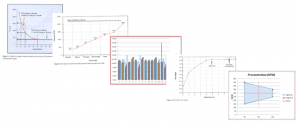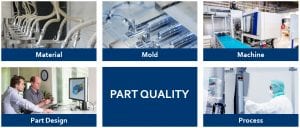Scientific moulding: your process window to success
What is scientific moulding?
Scientific moulding or scientific processing describes a systematic approach towards the totality of process stages from the material entering the facility to the shipping of the produced final goods.
For this, every stage of the manufacturing process is examined individually and the fluctuations of each step are minimized in order to create the most robust and reliable setting.
Try and error was yesterday
When it comes to complex polymer products, where the components have critical requirements to the function or the safety of the application, the setting up of the injection moulding process for serial volumes involves quite a lot of guesswork based on experience and trials until the parameters reach a sufficiently stable level. This is now turned around by implementing the scientific approach of collecting comprehensive data, developing and testing a hypothesis and analyzing the outcome to achieve repeatable results. The experience is therefore recorded and turned into useable data which helps to define and improve the process upfront.
“By minimizing the variations over the full production stages we are able to achieve more reliable and repeatable processes, which allows us to reach maximal part quality with zero defects in short time and minimal fluctuations” says Arjen Pekaar – Engineering and Quality Manager of Helvoet in the Netherlands.
The principle pillars
Before the moulding of the components can begin, the key elements need to be determined:
- Develop a part design that meets the customer’s requirements
- Select the right material and type (considering feasibility, functionality and cost)
- Develop the mould design and mould within quality and economical specifications
- Select the injection moulding machine to make parts with consistent quality
- Develop a robust process with consistent quality from part to part and run to run
Setting up the moulding process
In the development of a robust process with predictive results, it is important to achieve a consistency from cavity to cavity, part to part and run to run while variations in the process are merely depending on natural causes which cannot be influenced.
Let us guide you through the different steps of the moulding stage:
- Mould and melt temperature settings are the nominal value indicated by the material supplier
- A viscosity study provides information about the minimal injection speed where the viscosity tends to become constant
- A pressure drop study provides information if the selected machine has enough injection pressure and on which areas there is a higher flow resistance
- A balance study provides information on the differences in filling of the cavities and shot to shot
- A holding time study provides information on the effectiveness of the packing phase
- A cooling study provides information on the quality effect on the cycle time
- A shrinkage study provides information on the dimensional properties in time
- A DOE (Design of Experiments) study provides information on relationships between part quality and process input
- A process capability study provides information on the process variations and the dimensional average

After each of the before mentioned steps and based on the data collected, a “Go/No-go” decision is to be made, while “Go” means moving forward to the next step and “No-go” means a modification of the tool / design or parameters.
When all the 9 steps are green with a “Go” the robustness of the process is evident and there is sufficient information to tweak the final dimensions which are close-to or out specification. Finally a zero-production run will prove that the part, process, quality and economic targets are reached. The process has to be optimized already before the PPAP sampling starts.
Key benefits of Scientific Moulding
The list of advantages of applying scientific moulding is long, let us summarize some of them for you:
- Robust and reliable process with zero-defect part quality
- Know why you are in control: setup based on facts and not trial and error
- Optimized part, mold and process on all aspects
- Higher efficiency and less material consumption
- Predictable repeatability
= savings in time and cost
At Helvoet Group we always strive for the optimum manufacturing setup for your product and its specific requirements. Let us know if you have questions on Scientific Moulding or how we can establish the best process to produce your part!

